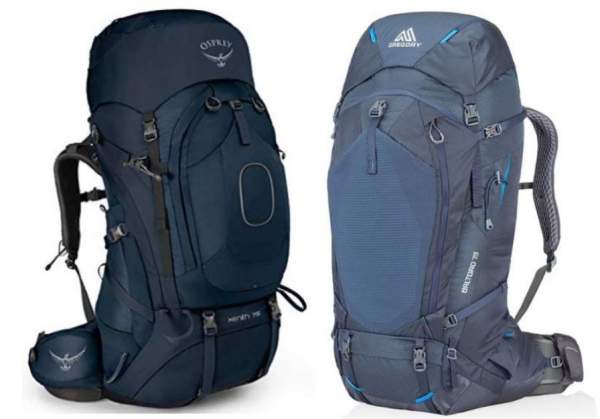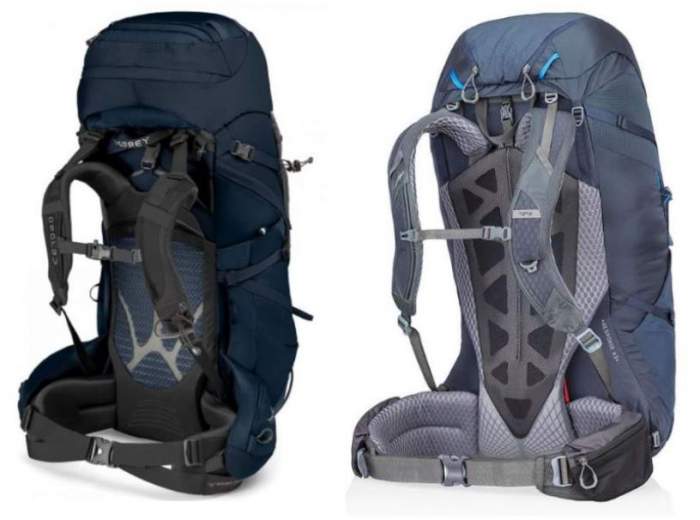Here I give a comparison Osprey Xenith vs Gregory Baltoro backpacks and my conclusion is that the Xenith is a better series. Please read why.

Why this text
Both Osprey Xenith and Gregory Baltoro series have been updated in 2018. The changes in the Baltoro packs have been more substantial. These two series are the flagships of the corresponding brands, and the largest they have, so it makes sense making such a comparison for those who are in search for a large and load-hauling pack.
Which sizes they offer
In the Baltoro series you have Baltoro 65, Baltoro 75, and Baltoro 85, and also Baltoro 75 GZ and Baltoro 95 Pro. So this is a series of very large packs designed for heavy loads. This is the best known of all Gregory’s series.
The Xenith series includes the Xenith 75, Xenith 88, and Xenith 105 packs and these are the largest backpacks built by Osprey so far.
Osprey Xenith series
The basic features of the Osprey Xenith packs are summarized as follows:
- Each of the nominal size mentioned above is in fact built in 3 sub-sizes. This means that you have M, L, and XL sizes for each of them. For example, the Xenith 75 pack has the sizes of 75, 79, and 83 liters, and those are the M, L, and XL sizes for this model. The same holds for the other two, the 88 and 105 liters packs.
- You have what they call the BioForm hip belt. This means that the belt forms to your body due to the body heat.
- The packs are also with the ErgoPull design on the hip belt. This includes dual V-shaped front straps on both sides of the belt and they provide the best hugging of the hip bones.
- The packs have Osprey’s AirScape back panel and suspension system. So you have a ridged back panel covered by a very breathable mesh.
- Each of the packs has 3 access points to the main compartment and this includes the top access and two zippered entrances from the two sides. There is also an access through the bottom compartment.
- The packs are with a removable lid which transforms into the DayLid daypack. This is the most important of the mentioned new features introduced in the 2018 version. You will hardly find a more functional daypack of that type on the market.
- The torso size is adjustable and you have a Velcro connection which allows for a really perfect fit.
- Weight capacity is the same for all packs – 70 lb (32 kg).
- The packs are with an external reservoir sleeve behind the harness.
- Here you also have Osprey’s famous Stow-on-the-Go attachment system for poles.
- There is no rain cover included.
- There are 9 pockets in total.
A few more details you can see in this short video by Osprey:
Gregory Baltoro Packs
The most important features in the Baltoro packs are as follows:
- Built in three sub-sizes within each of the nominal sizes.
- The load capacity depends on the pack size. The Baltoro 65 pack has the load capacity 51 lb (23 kg), Baltoro 75 has 55 lb (25 kg), Baltoro 85 is designed for 60 lb (27 kg), while Baltoro 95 Pro can support 75 lb (34 kg).
- A3 (Auto Angle Adjust) system. It is applied to both the hip belt and shoulder harness. This is a great design which allows for independent pivoting and this reduces fatigue and saves energy when you go over a rugged terrain.
- Matrix ventilated back panel. This is a new feature introduced in the 2018 version. They use the same design in some other of their packs, like the Paragon and Maven.
- There are two access points to the main compartment, from the top and from the front. But you also have the access from the bottom compartment.
- The packs are with no less than 15 different combinations in sizes for the hip belt and harness. This guarantees that you should find the best fit for your body size.
- There are 2 positions for the torso length so this is not a full torso adjustability.
- QuickStow attachment system for glasses.
- Hydration sleeve doubles as a daypack.
- Crossover side compression straps.
- Rain cover is included.
- There are 10 pockets.
Please see the new Baltoro series in this video by Gregory:
Below are the packs from the two series showing their suspension and back panel design:

Which series is better?
Here I give my summary table and below you will see my reasons for giving those plus and minus votes:
Harness
Torso adjustability
Hip belt
Ventilation
Attachment points
Pockets
Volume/Weight ratio
Weight capacity
Access points
Reservoir sleeve
Daypack
Rain cover
Price
Osprey Xenith
Gregory Baltoro
The harness: In both series you have multiple combinations for the sizes, so you can always find the best fit. But the Baltoro series has what they call the A3 system, i.e., the Auto Angle Adjust system. It allows for the left and right harness and hip belt sections to rotate independently of each other. This is an excellent design and this is what makes the Baltoro harness better.
Torso adjustability: The Xenith packs have a fully adjustable system, while Baltoro has only two separate positions. So I think the winner is clear.
The hip belt: Xenith packs come with the BioForm foam, and it also has the extra ErgoPull system. I am convinced that this is the best design currently on the market. Note that you have a similar ErgoPull system in some other brands, without the same name of course, but only here in the Xenith packs this is combined with the form-shaping foam.
Ventilation: Both series have a ventilated back system, it is not perfect but I would say they are on the same level.
Attachment elements: Here the situation is a bit tricky. The Xenith packs are with the Stow-on-the-Go system plus the usual stuff. On the other hand, the Baltoro packs have all the usual elements plus the QuickStow for glasses and the Crossover straps design. So I would say they are very close here, but this all is the matter of preference. I guess I would rather have the Stow-on-the-Go system than the two mentioned features on Baltoro packs.
The pockets: The Xenith packs have 9 pockets, while you have them 10 in the new Baltoro packs. As I see it, 10 is better than 9. Is it so crucial? Not really.
Volume/Weight ratio is very close in both series, but Xenith is slightly better with V/W = 32, 37, and 41 liters/kg for the three nominal sizes. Compare this with V/W = 30, 33, and 36 liters/kg for the three Batoro packs.
Weight capacity: You have seen the numbers above, I would say that although they are very close in average Xenith packs are slightly better.
The access points: You have one more in the Xenith packs, they have access from both sides and from the top. The Baltoro pack has the top and front entry points. Is this crucial? I do not think so, you have a good access in bot packs.
The reservoir sleeve: Having an external reservoir sleeve is an advantage, you do not have to mess with the stuff in the main compartment when you refill. So the Xenith is a clear winner.
Daypack: Both series have daypacks. In the Xenith packs the lid is removable and it transforms into a very functional daypack. In the Baltoro series the reservoir sleeve from the main compartment doubles as the daypack. I am sure here, the Xenith daypack is a far better option.
Rain cover: Note that Xenith packs in EU come with a rain cover, but they do not have the new DayLid daypack. As far as I know, on the US market the Xenith packs are without a rain cover. But Baltoro packs are with a rain cover so they are a winner here.
The price: Here it is a bit difficult. There are many sellers, this is not surprising in view of the quality and the popularity of these packs. My feeling is that Baltoro packs are a bit more affordable but both series are really expensive so minus for both. Note also that both new and previous versions are available on the market so do not get lost if you check.
Osprey Xena vs Gregory Deva packs
Both brands build the corresponding women-specific versions as well, so you have the Xena packs for women corresponding to Xenith packs for men. In the case of Gregory, they have Deva packs for women corresponding the Baltoro packs for men.
The features in Xenith & Xena and in Baltoro & Deva are the same. So my conclusions are the same, the Osprey Xena series gets a better rating than the Gregory Deva series. See more in my Osprey Xena 70 review.
Final thoughts
You might feel lost with all these features, this is normal when you have such incredible items. So let me focus a bit more on the basic and the most important features.
♦ A pack of such a size is designed to carry a heavy load, so good harness and hip belt are essential. Packs are built for some “standard” people, but this will not help you much if you are not in such a group (whatever this may be). So the elements like the harness, hip belt, and torso adjustability should be looked upon as one integral element of the design and this is the most important part of such packs.
What I want to say is that it is essential that the hip belt sits where it should, hence the need for torso adjustability. On the other hand, it is also important how the hip belt hugs the hip area. In the Xenith packs you have this at its best with the ErgoPull and BioForm designs. So this is why I think that Xenith is better.
♦ Rain cover is absolutely essential for me, I go to the Alps and you can have rain and even snow any time and in any season, but this may not be essential to you. Xenith packs are without a rain cover, but you can order it separately here and this problem is solved.
Some people use plastic bags inside a pack. This is not my way, I have lots of items in the pockets of the backpack, so having a rain cover is a must.
♦ Having a daypack with such a large backpack may be very useful. The daypack which you have with Xenith packs is the best of this type (note that you have the same in their Aether & Ariel series).
Please check my detailed review of the Osprey Xenith 75 pack, and Gregory Baltoro 75 GZ and Gregory Deva 70 to see more about all the features mentioned above.
So what do you think? Did I miss something? Please share your thoughts, there is a comment box below.
Thank you for reading. Please use the comment box below in the case of comments or questions.
Leave a Reply